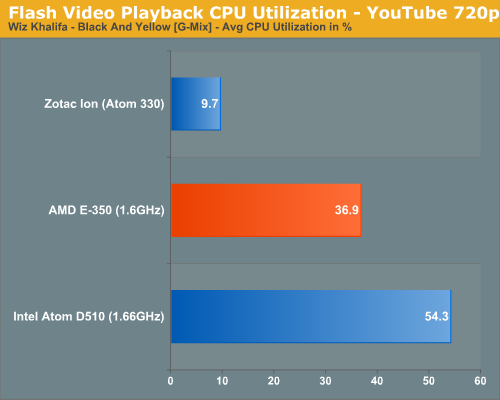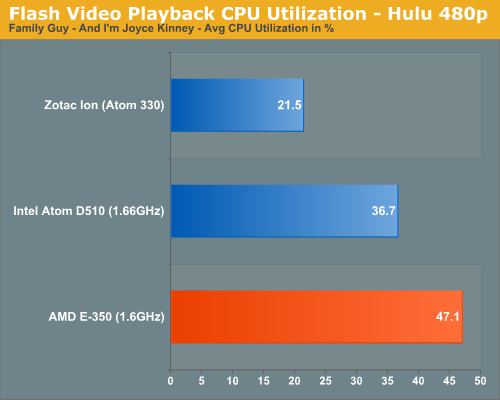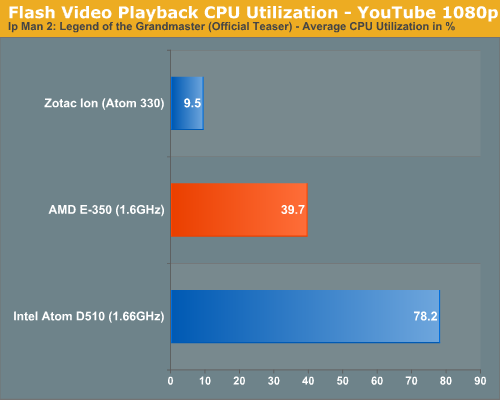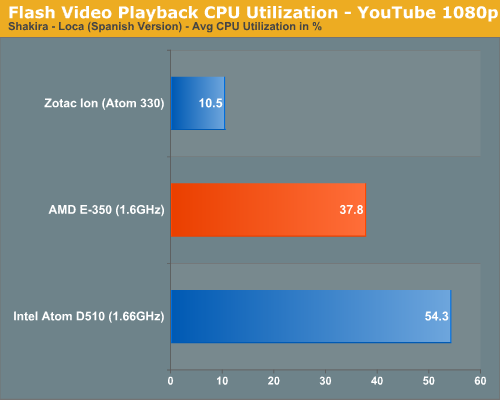The Brazos Review: AMD's E-350 Supplants ION for mini-ITX
by Anand Lal Shimpi on January 27, 2011 6:08 PM ESTBlu-ray & Flash Video Acceleration
Compatibility is obviously a strongpoint of Brazos. So long as what you’re decoding can be hardware accelerated you’re pretty much in the clear. But what about CPU utilization while playing back these hardware accelerated formats? The CPU still needs to feed data to the GPU, how many cycles are used in the process?
I fired up a few H.264/x264 tests to kick off the investigation. First we have a 1080p H.264 Blu-ray rip of Quantum of Solace, averaging around 15Mbps:
| Quantum of Solace 1080p H.264 CPU Utilization (1:00 - 1:30) | |||||
| Platform | Min | Avg | Max | ||
| AMD E-350 | 22.7% | 27.8% | 35.3% | ||
| Intel Atom D510 | Fail | ||||
| Zotac ION | 14.6% | 17.2% | 20.1% | ||
A standard Atom platform can’t decode the video but ION manages a 17% average CPU utilization with an Atom 330. Remember that the Atom 330 is a dual-core CPU with SMT (4-threads total) so you’re actually getting 17.2% of four hardware threads used, but 34.4% of two cores. The E-350 by comparison leaves 27.8% of its two cores in use during this test. Both systems have more than enough horsepower left over to do other things.
Next up is an actual Blu-ray disc (Casino Royale) but stripped of its DRM using AnyDVD HD and played back from a folder on the SSD:
| Casino Royale BD (no DRM) CPU Utilization (49:00 - 49:30) | |||||
| Platform | Min | Avg | Max | ||
| AMD E-350 | 28.1% | 33.0% | 38.4% | ||
| Intel Atom D510 | Fail | ||||
| Zotac ION | 17.7% | 22.5% | 27.5% | ||
Average CPU utilization here for the E-350 was 33% of two cores.
Finally I ran a full blown Blu-ray disc (Star Trek) bitstreaming TrueHD on the E-350 to give you an idea of what worst case scenario CPU utilization would be like on Brazos:
| Star Trek BD CPU Utilization (2:30 - 3:30) | |||||
| Platform | Min | Avg | Max | ||
| AMD E-350 | 29.0% | 40.1% | 57.1% | ||
At 40% CPU utilization on average there’s enough headroom to do something else while watching a high bitrate 1080p movie on Brazos. The GPU based video decode acceleration does work, however the limits here are clear. Brazos isn’t going to fare well as a platform you use for heavy multitasking while decoding video, even if the video decode is hardware accelerated. As a value/entry-level platform I doubt this needs much more explanation.
Now let’s talk about Flash.
I ran through a number of Flash video tests at both YouTube and Hulu ranging in resolution from 480p all the way up to 1080p. I used Flash 10.1, 10.2 beta as well as an unreleased version of 10.2 beta provided by AMD.


For the most part GPU accelerated Flash video does work well. Performance under both YouTube and Hulu was flawless, provided that I wasn’t watching 1080p content. Watching 1080p content in YouTube wasn’t entirely smooth on Brazos, despite posting very reasonable CPU utilization numbers.


I took my concerns to AMD and was told that this was a known issue with Brazos and Flash 10.1 and that 10.2 should alleviate the issue. AMD then supplied me with an unreleased version of Flash 10.2 to allow me to verify its claims. While 1080p playback improved with AMD’s 10.2 beta, it wasn’t perfect (although it was very close). AMD wouldn’t tell me the cause of the problem but it’s currently working on it with Adobe. At the end of the day I don’t believe it’s a dealbreaker, but early Brazos adapters should expect some stuttering when playing back 1080p YouTube videos. Note that 720p and lower resolution videos were perfectly smooth on Brazos.










176 Comments
View All Comments
Matt310 - Friday, January 28, 2011 - link
At home in my desktop machine I have a 4-lane PCI-x hardware RAID card with four 1.5TB drives configured in RAID 5 for speed hand fault tolerance. For a while now I've been wondering how the i/o performance of a good RAID card would fair if it was moved to a low-power (e.g. Atom- or Brazos-based) mini-ITX NAS system. I've been googling for a review of this setup but not been able to find anything conclusive.Think a lot of people would appreciate if you guys could give this a try and report on your findings!
Thanks Anand!
msroadkill612 - Friday, February 4, 2011 - link
Well you should know - dont the raid cards have their own smarts & put little work on the cpu?My guess is it would be a great unit for a dedicated server. In the old days, many dedicated servers kept their 486 pcS for a decade as they ran fine.
a post above linked to a comparison of running pciE graphics cards at 1,4,8,16 lanes, & the difference between 4 x &16 by was slight. I imagine its the same with raid cards.
jjcrandall - Friday, January 28, 2011 - link
Anand, I didn't see what hdd you used for the tests. It would be very interesting to see how this platform performed in some of the benchmarks with a ssd. I know pcmark & vantage productivity benches use hdd test's to a certain degree.This really shows either how poor netburst was as an architecture, or how good existing sub 10w designs are.
Shadowmaster625 - Friday, January 28, 2011 - link
It seems like the E-350 was built for overclocking. Especially on the desktop or with any cooling solution that has an extra 10 Watts of thermal headroom. Sooner or later someone is going to release a mini-ITX board that can OC an E-350 up to 2.5GHz and beyond. Right? It's not like the new intel cpu where you cannot overclock it, right?bjacobson - Saturday, January 29, 2011 - link
yeah I definitely want to overclock it!In a laptop when you've got an 8-10 hour battery life, if you know you're only going to need the laptop for 4 hours today, why not just crank up the speed? Great having that option.
Arnulf - Friday, January 28, 2011 - link
"Unfortunately in modern titles that's not always enough to have a playable experience, but with older games you should be able to do more with Brazos than you ever could with Atom or even ION for that matter. The CPU/GPU balance in the E-350 is good enough that I feel like Llano could make for a pretty decent value gaming machine."Given that Zacate/Brazos performs at the level of 5+ years old midrange desktop CPU with midrange GPU and considering the quoted statement above it would be very interesting to see some actual performance data taken in titles that Zacate/Brazos *can* run at bearable FPS rates.
You could look up your performance charts from 5 years ago, dig out the old titles and rerun the benchmarks with those titles on Zacate/Brazos. This should give people better idea what they can expect from this generation of APUs. Sub-20 FPS rates in modern titles at rather low resolution and with all details at minimum isn't exactly what people have their sights on when deciding whether to shell out money for their new toy. Comparison with other crappy graphics that is on par with 5 year old solutions may give AMD's platform some edge over competition from Intel's camp, but it utterly meaningless as nobody is planning to use it in such setting.
Myself, I'd *love* to see some factual data from titles such as CoD2, DiRT, Doom3, etc. - the games you were referring to in the paragraph quoted above and all of which you already have reference benchmarks of (in order to have something to compare Zacate/Brazos against, without having t rerun all the benchmarks with old software titles). Such a benchmark with usable performance and enough eye candy will help put Zacate/Brazos' use in gaming setting into perspective, very much unlike those ~20 FPS tests you did above.
These merely indicate that integrated graphics of today are still useless for gaming.
bjacobson - Saturday, January 29, 2011 - link
Hm that's a good point. Likely I'd be playing a copy of UT2k4, perhaps quake 3 online, or some older online RTS. How do these fare at those games?cjs150 - Friday, January 28, 2011 - link
Nice review.There is a passively cooled E-350 board coming out. The review convinces me that this will be the right choice for the HTPC for the main room.
Why: TV already connected to an AV receiver so an E-350 system can use the HDMI connection to the AV receiver. E350 more than powerful for BluRay, fine for some light web surfing, ripping music. Maybe stick a TV tuner in as well and that is the main room sorted.
I have no intention of playing modern games on it so lack of power is not a problem. I have a bigger PC in study to rip movies if it takes too long on the E350.
But I also have an Atom based system. Again passively cooled. I use it as a server for the home network. It works just fine. It was cheap, ultra easy to build and just works. The fact that Atom is rubbish does not matter because as long as it can shift data round the network I need nothing more.
So every CPU has a purpose, just with some we have to look hard
BernardP - Friday, January 28, 2011 - link
AMD might score technical successes with its new lineup (Bobcat, llano, Bulldozer), but it will have trouble marketing them if only meaningless C Series, E Series, A series (Llano) and whatever Series (Bulldozer) are used.last time I looked, a C350 and E350 were Mercedes-Benz models, while CSeries is an upcoming Bombardier jet:
http://en.wikipedia.org/wiki/Bombardier_CSeries
In addition the numbers seem meaningless. Even intel's Core naming scheme is clearer than AMD's.
AMD simply needs 3 distinct marketing names that the general public will understand for its 3 new product lines code names: Bobcat - Llano - Bulldozer. "Fusion" and "Vision" just don't cut it anymore, as they have already been used for years by AMD.
One can easily see that there is a problem is the naming scheme when OEMs have to use the Zacate and Brazos code names to try to describe the product, like this example:
http://www.asus.com/product.aspx?P_ID=9BmKhMwWCwqy...
nitrousoxide - Friday, January 28, 2011 - link
Yeah...the naming scheme ASUS and ACER use makes people mad when choosing laptops :)